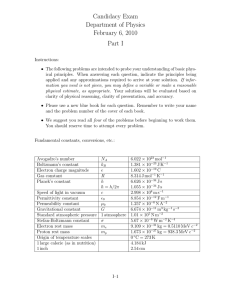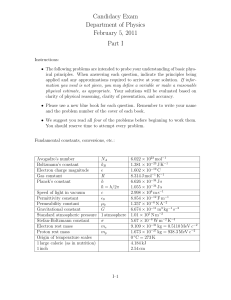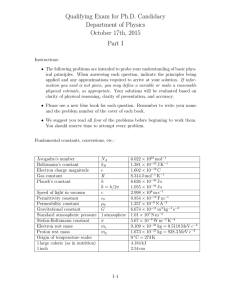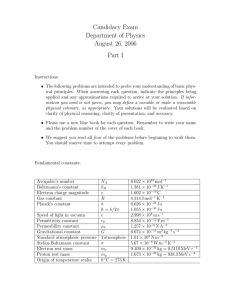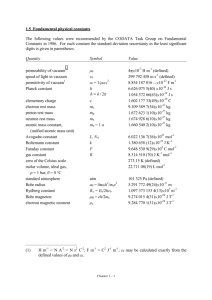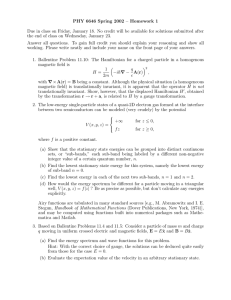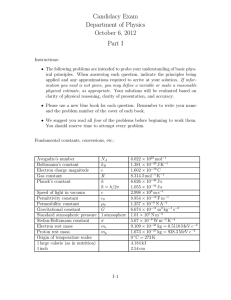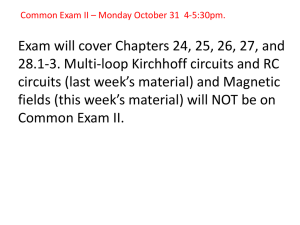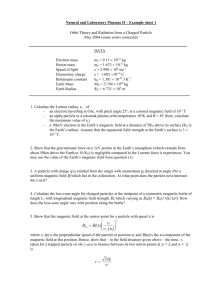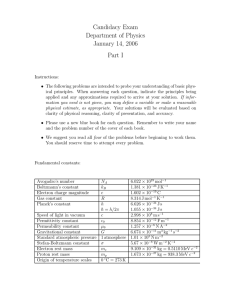Candidacy Exam (corrected) Department of Physics October 3, 2009 Part I
advertisement
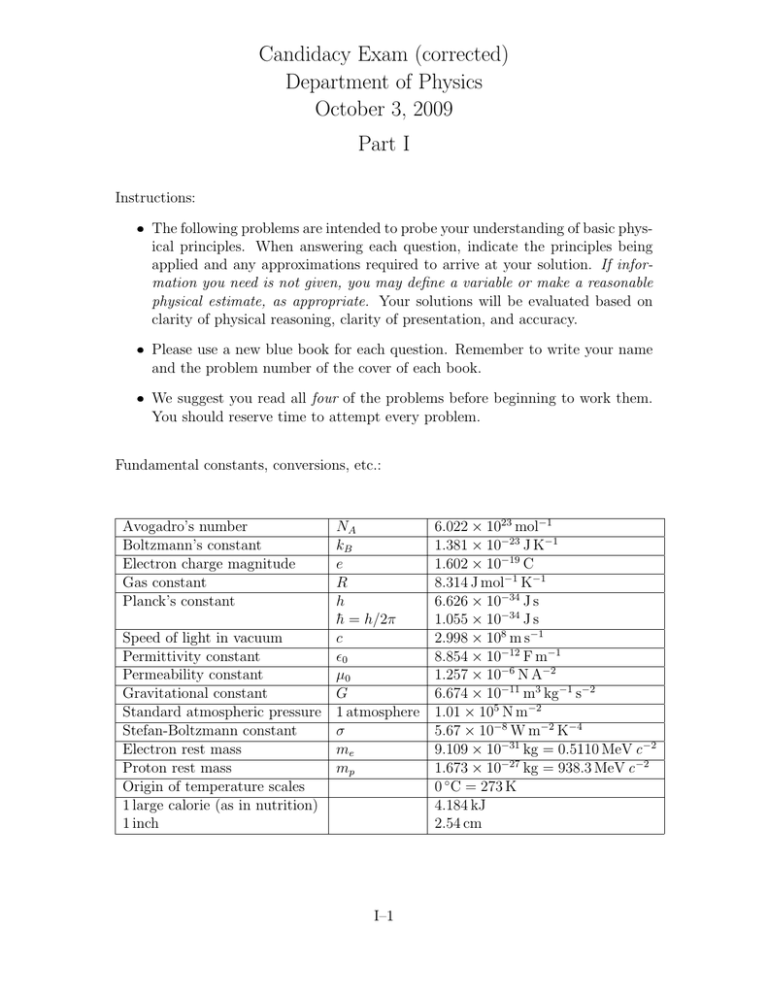
Candidacy Exam (corrected) Department of Physics October 3, 2009 Part I Instructions: The following problems are intended to probe your understanding of basic physical principles. When answering each question, indicate the principles being applied and any approximations required to arrive at your solution. If information you need is not given, you may define a variable or make a reasonable physical estimate, as appropriate. Your solutions will be evaluated based on clarity of physical reasoning, clarity of presentation, and accuracy. Please use a new blue book for each question. Remember to write your name and the problem number of the cover of each book. We suggest you read all four of the problems before beginning to work them. You should reserve time to attempt every problem. Fundamental constants, conversions, etc.: Avogadro’s number Boltzmann’s constant Electron charge magnitude Gas constant Planck’s constant NA kB e R h h̄ = h/2π Speed of light in vacuum c Permittivity constant 0 Permeability constant µ0 Gravitational constant G Standard atmospheric pressure 1 atmosphere Stefan-Boltzmann constant σ Electron rest mass me Proton rest mass mp Origin of temperature scales 1 large calorie (as in nutrition) 1 inch I–1 6.022 × 1023 mol−1 1.381 × 10−23 J K−1 1.602 × 10−19 C 8.314 J mol−1 K−1 6.626 × 10−34 J s 1.055 × 10−34 J s 2.998 × 108 m s−1 8.854 × 10−12 F m−1 1.257 × 10−6 N A−2 6.674 × 10−11 m3 kg−1 s−2 1.01 × 105 N m−2 5.67 × 10−8 W m−2 K−4 9.109 × 10−31 kg = 0.5110 MeV c −2 1.673 × 10−27 kg = 938.3 MeV c −2 0 ◦ C = 273 K 4.184 kJ 2.54 cm I–1. A uniform spherical solid ball rolls with a center-of-mass velocity v. The ball is of mass m and radius a. (a) What is its total kinetic energy? (b) The ball rolls on parabolic track of the form y(x) = βx2 , where β is a positive constant, x is horizontal position, and y is vertical position. As the ball rolls back and forth, the maximum height of its center of mass is h0 . What is its maximum velocity? I–2. A quantum mechanical particle of mass m is situated on a line with the following potential: ( 0 : 0 < x < a, V (x) = (I–1) +∞ : x < 0, x > a. Its initial wave function is ψ(x, t = 0) = A sin3 (πx/a). Find the wave function at arbitrary time t > 0. Does the particle return to the initial state at some time T ? I–3. Consider a rectangular wave guide along the z-axis, assuming the electric and magnetic fields to be of the form i(ωt−k z) i(ωt−k z) z z ~ = Re ~h(x, y)e ~ = Re ~e(x, y)e H , E . (I–2) (a) Use the x- and y-components of Faraday’s and Ampère’s laws to determine the transversal field components in terms of ez and hz . (b) Use Maxwell’s equations to derive the Helmholtz equation ∂2f ∂2f + + p2 f = 0 ∂x2 ∂y 2 (I–3) for ez and hz , and identify p. (c) Solve the Helmholtz equations for TM modes, where Hz = 0, by separation of variables. Which frequencies ω are possible for given side lengths a and b of the wave guide’s cross-section. I–2 I–4. An atom has a magnetic moment ~µ. In a particular crystal it can only be oriented in any of the six directions ±x, or ±y, or ±z, and in the absence of a magnetic field, each of these 6 states has the same energy. Now assume that a fixed magnetic field points in the ẑ-direction. (a) What is the partition function at nonzero temperatures for the magnetic system? (b) Derive a formula for the average magnetic moment h~µi as a function of temperature and magnetic field. I–3 Candidacy Exam (corrected) Department of Physics October 3, 2009 Part II Instructions: The following problems are intended to probe your understanding of basic physical principles. When answering each question, indicate the principles being applied and any approximations required to arrive at your solution. If information you need is not given, you may define a variable or make a reasonable physical estimate, as appropriate. Your solutions will be evaluated based on clarity of physical reasoning, clarity of presentation, and accuracy. Please use a new blue book for each question. Remember to write your name and the problem number of the cover of each book. We suggest you read all four of the problems before beginning to work them. You should reserve time to attempt every problem. Fundamental constants, conversions, etc.: Avogadro’s number Boltzmann’s constant Electron charge magnitude Gas constant Planck’s constant NA kB e R h h̄ = h/2π Speed of light in vacuum c Permittivity constant 0 Permeability constant µ0 Gravitational constant G Standard atmospheric pressure 1 atmosphere Stefan-Boltzmann constant σ Electron rest mass me Proton rest mass mp Origin of temperature scales 1 large calorie (as in nutrition) 1 inch II–1 6.022 × 1023 mol−1 1.381 × 10−23 J K−1 1.602 × 10−19 C 8.314 J mol−1 K−1 6.626 × 10−34 J s 1.055 × 10−34 J s 2.998 × 108 m s−1 8.854 × 10−12 F m−1 1.257 × 10−6 N A−2 6.674 × 10−11 m3 kg−1 s−2 1.01 × 105 N m−2 5.67 × 10−8 W m−2 K−4 9.109 × 10−31 kg = 0.5110 MeV c −2 1.673 × 10−27 kg = 938.3 MeV c −2 0 ◦ C = 273 K 4.184 kJ 2.54 cm II–1. A newtonian particle of mass m falls under the influence of the earth’s gravity (treated as uniform). It experiences a viscous drag force kv, where k is a constant and v is the particle’s speed. The particle released from rest at a height h0 at time t = 0. Obtain its height h(t) as a function of time t? II–2. Two identical quantum-mechanical particles of mass m are confined to a line where there is a potential V (x). All the single-particle energy eigenstates are bound states and are non-degenerate. Let the single-particle energy eigenvalues be E1 , E2 , etc, in order of increasing energy. You should neglect all interparticle interactions. (a) For the two-particle system, what are the two lowest eigenenergies when the particles are spinless bosons? Express your answer in terms of the single-particle energies. (b) What if they are spinless fermions? (c) What if they are spin-1/2 fermions? II–3. Two rings of radii R are placed in parallel planes at distance L from each other such that the line connecting their centers is orthogonal on the planes (see figure). Each ring has a uniform positive charge density and total charge Q. A small bead of positive charge q and mass m is constrained to move on the line connecting the centers of the two rings. Find: (a) The equilibrium position of the bead. (b) The period of small oscillations about that position. R R L II–2 II–4. An enclosure contains a classical ideal gas at pressure p and has in one of its walls a small hole of area A through which molecules pass into vacuum. In this vacuum, directly in front of the hole at a distance L from it, there is a suspended circular disk of radius R. It is oriented such that the normal to its surface points towards the hole. Assuming that the molecules escaping from the enclosure are scattered elastically from the disk, find the force exerted on the disk by the escaping molecules, in the limit that the size of the hole is much less than L and R. Base your answer on the Maxwell-Boltzmann distribution. II–3
